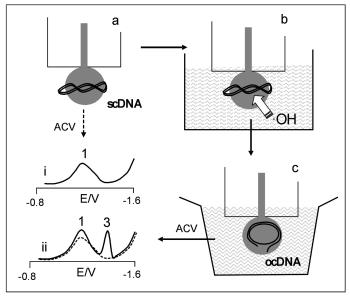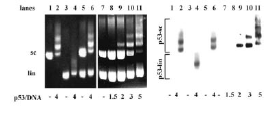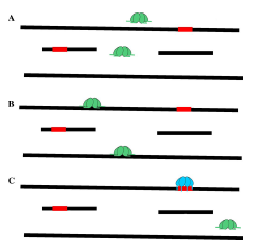DBCMO
Research profile
The Department of biophysical chemistry and molecular oncology (DBCMO) studies the structure of nucleic acids (NA), proteins and other biologically important molecules in solutions and at surfaces; it is engaged in electrochemical analysis of NA and proteins and develops electrochemical biosensors. The LBCMO investigates in greater detail relationships between the DNA structure and its interactions with proteins (namely, to the tumor suppressor protein p53).
Electrochemistry of nucleic acids and electrochemical DNA biosensors
In the field of electrochemical analysis of nucleic acids IBP possesses the world primacy thanks to the discovery of DNA electro activity, made by Emil Paleček more than 40 years ago [Nature 188 (1960) 656-657]. Since then, the LBCMO intensively deals with the study of the behavior of nucleic acids on electrodes and in solutions which resulted in laying foundationsof the nucleic acids electrochemistry in the 1960's-1980's. In the long-term, this research is extraordinarily fruitful as evidenced by number of publications, including invited reviews by the laboratory members.
At present time, interactions of nucleic acids with electrodes are intensively studied in many laboratories because of expectations that electrochemical biosensors using NAs as recognition layers will soon become important tools in various research and practical areas, including medicine. Since 1995 LBCMO contributed significantly to the progress in the research of NA with electrodes including (a) increase in sensitivity of the analysis of NAs (and proteins) with carbon electrodes by 2-3 orders of magnitude; (b) systematic studies of the peptide nucleic acid (PNA) and its application as a recognition layer in the biosensors for the DNA hybridization which lead to the first electrochemical detection of the single-base mismatch (point mutation) in DNA, (c) systematic studies of circular DNAs which resulted in their application in the electrochemical detection of the DNA damage; (d) introduction and application of "double-surface" electrochemical techniques (using magnetic beads) in studies of DNA hybridization and DNA-protein interactions.
At present, the work in this area is focused mainly on:
- detailed studies of electrochemical and interfacial behavior of synthetic oligonucleotides (ODN) with respect to nucleobase content and nucleotide sequence
- studies of nucleic acids (NA), ODN and NA components interactions with different electrode surfaces
- studies of electrochemical and interfacial behavior of chemically modified (functionalized) ODN on mercury, solid amalgam and gold electrodes
- labeling on nucleic acids with electrochemically active moieties
- development of electrochemical techniques for the detection of DNA hybridization
- electrochemical behavior of damaged DNA and development of sensors for DNA damage

Recent reviews of nucleic acids electrochemistry:
E. Palecek, M. Fojta, F. Jelen, and V. Vetterl, Electrochemical analysis of nucleic acids, in The Encyclopedia of Electrochemistry, in Bard, A. J., and Stratsmann, M., (Eds.), Wiley-VCH, Weinheim, 2002, pp. 365-429.
M. Fojta, Electrochemical Sensors for DNA Interactions and Damage, Electroanalysis 14 (2002) 1449-1463.
M. Fojta, Mercury Electrodes in Nucleic Acid Electrochemistry: Sensitive Analytical Tools and Probes of DNA Structure, Collect. Czech. Chem. Commun 69 (2004) 715-747.
E. Palecek, and M. Fojta, Electrochemical DNA Sensors, in Bioelectronics, in Wilner, I., and Katz, E., (Eds.), Wiley VCH, Weinheim, 2005, pp. 127-192.
M. Fojta, Detecting DNA damage with electrodes, in Electrochemistry of nucleic acids and proteins. Towards electrochemical sensors for genomics and proteomics, in Palecek, E., Scheller, F., and Wang, J., (Eds.), Elsevier, Amsterdam, 2005, pp. 386-430.
E. Palecek, and F. Jelen, Electrochemistry of nucleic acids., in Electrochemistry of nucleic acids and proteins. Towards electrochemical sensors for genomics and proteomics., in Palecek, E., Scheller, F., and Wang, J., (Eds.), Elsevier, Amsterdam, 2005, pp. 74-174.
E. Palecek, Polarography of DNA. Retrospective view., in Electrochemistry of nucleic acids and proteins. Towards electrochemical sensors for genomics and proteomics., in Palecek, E., Scheller, F., and Wang, J., (Eds.), Elsevier, Amsterdam, 2005, pp. 1-17.
V. Vetterl and S. Hasoň, Electrochemical properties of nucleic acids components, in Electrochemistry of nucleic acids and proteins. Towards electrochemical sensors for genomics and proteomics., in Palecek, E., Scheller, F., and Wang, J., (Eds.), Elsevier, Amsterdam, 2005, pp. 17-71.
Electrochemistry of proteins and novel micromethods for protein analysis
Protein electrochemistry in the LBCMO has been systematically pursued during the latest years. The research is directed especially towards study of proteins which do not contain "non-protein" redox centers and exhibit electrochemical activity due to the presence of particular amino acids and due to catalysis of hydrogen evolution. This approach is almost unique in context of world science and it opens new possibilities of electrochemical methods application for the study of protein structure and interactions. An important result of the laboratory is the discovery of catalytic signal, so-called "peak H" [Electroanalysis 10 (1998) 403-409] which is yielded under certain conditions by peptides and proteins on mercury electrodes. This signal not only enables highly sensitive detection of nonlabeled proteins but also specifically responses to protein denaturation and aggregation. We have recently shown that using electrochemical techniques, aggregation of alfa-synuclein, a protein involved in Parkinson's disease, can be detected in its early stages.

At present, the work in this area is focused mainly on:
- electrochemical properties of synthetic peptides focused on roles of particular amino acid residues in interactions with the electrode surface, electron transfer reactions and catalytic hydrogen evolution
- denaturation and aggregation of proteins, particularly those involved in serious disorders (such as cancer or neurodegenerative diseases)
- effects of protein interactions with other molecules (e.g., avidin-biotin) on electrochemical and interfacial behavior of the proteins
- covalent modification of peptides and proteins with electrochemically active groups
- development of electrochemical techniques for the detection of protein-DNA interactions

A review of protein electrochemistry:
E. Palecek, Electroactivity of proteins and its possibilities in biomedicine and protemics., in Electrochemistry of nucleic acids and proteins. Towards electrochemical sensors for genomics and proteomics., in Palecek, E., Scheller, F., and Wang, J., (Eds.), Elsevier, Amsterdam, 2005, pp. 690-750.
Tumor suppressor proteins
The tumor suppressor protein p53 is among the most intensively studied topics of the contemporary biology because of its importance for cancer prevention and pathogenesis as well as for the future rational cancer therapy. In the LBCMO a new type of the interaction of p53 protein with DNA was discovered - the preferential p53 binding to supercoiled (sc) DNA [Oncogene 15 (1997) 2201-2209]. It has been found that p53 binds to scDNA not containing the specific binding site for p53 with much higher affinity than to linear DNA containing the same nucleotide sequence. Further studies (performed in collaboration with theMasaryk Memorial Cancer Institute have shown that the carboxy-terminal domain of the protein p53 and oligomeric state are crucial for this phenomenon and that DNA superhelicity affects sequence-specific binding of p53 to its target sites. These findings are in accordance with more recent results of other laboratories, which indicate that the DNA conformation is an important factor influencing the interactions of p53 with DNA and probably also its function in the cell.
 |
 |
At present, the work in this area is focused mainly on:
- interactions of wild type (wt) and mutant (mut) p53 proteins with specific target sites in vitro and in cells
- effects of DNA conformation and/or topology on these interactions
- p53 and p73 interactions with damaged DNA (particularly with DNA modified with antitumor platinum complexes - collaboration with LMBP)
- effects of wt and mut p53 posttranlational modifications on interactions with DNA and with other proteins in vitro and in cells
- functional consequences of wt and mut p53-DNA interactions in cells

